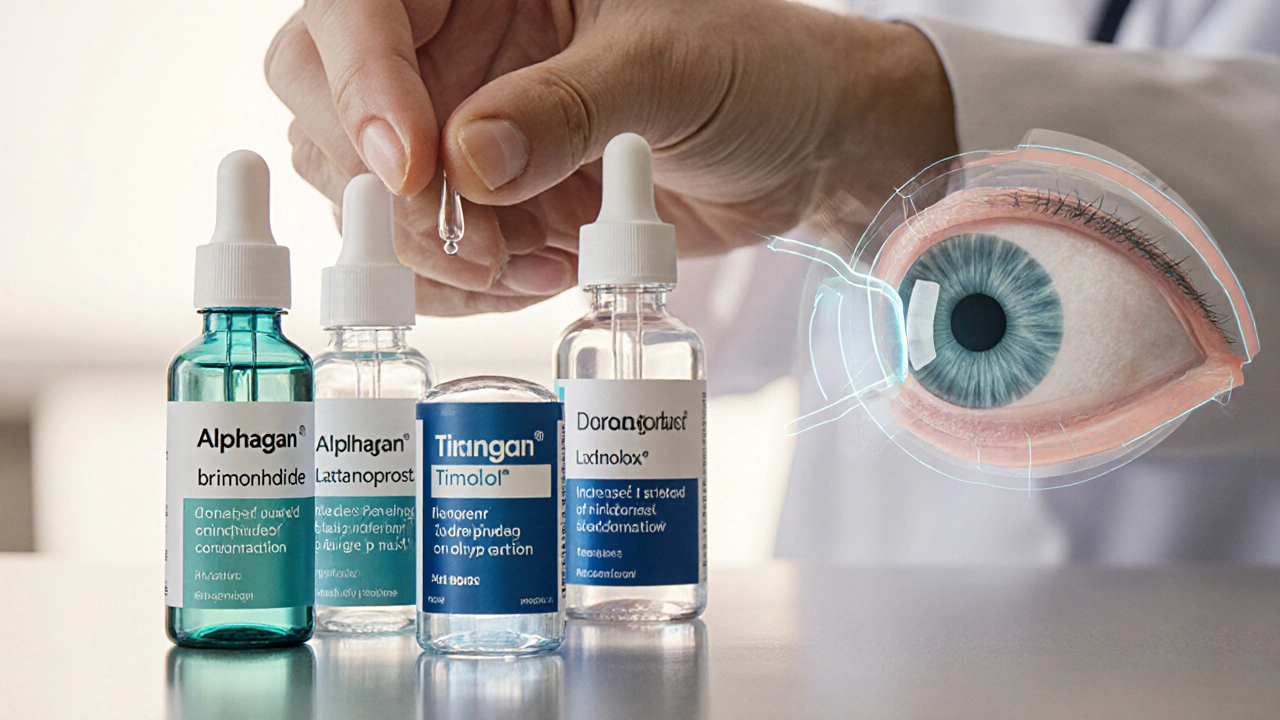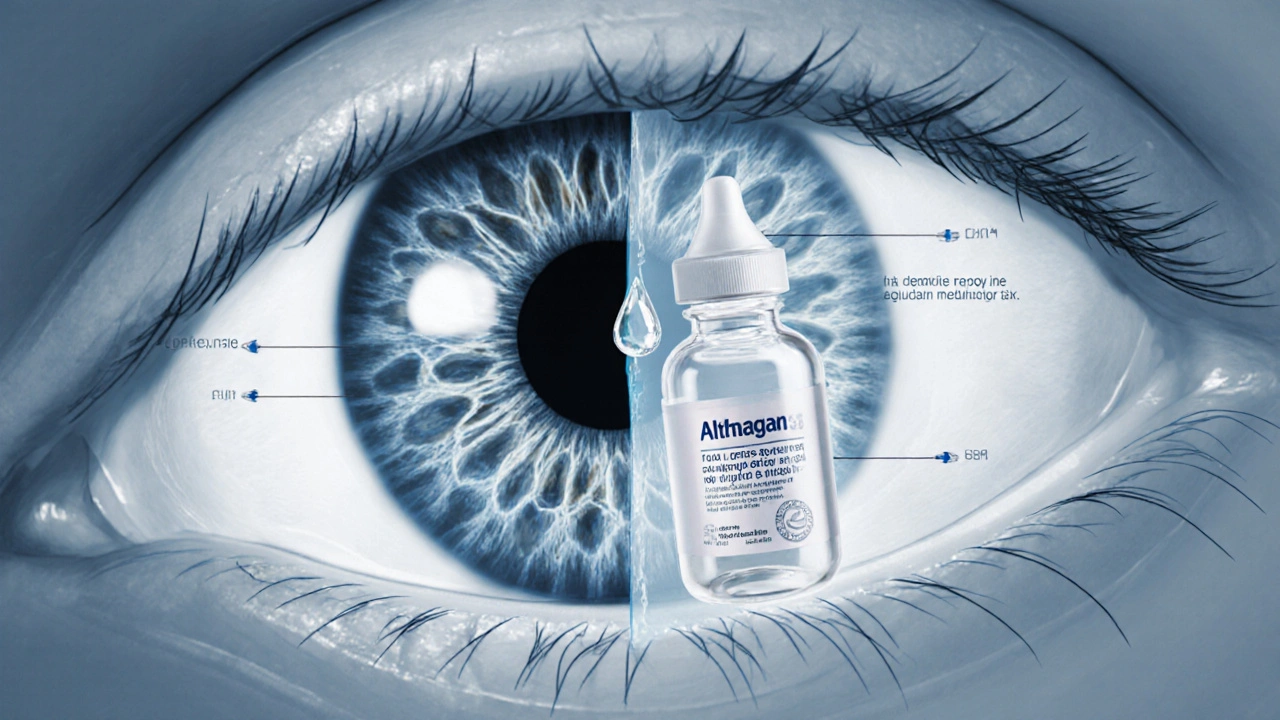Glaucoma Medication Selector
Select Your Priorities
Answer a few quick questions to find the best glaucoma eye drop for your situation.
Key Takeaways
- Alphagan (brimonidine) lowers eye pressure by reducing aqueous humor production and increasing outflow.
- It works well for mild to moderate glaucoma but can cause redness and allergic reactions in some users.
- Prostaglandin analogs like latanoprost and bimatoprost usually give the biggest pressure drop (≈25‑30%) with once‑daily dosing.
- Beta‑blockers such as timolol are cost‑effective but unsuitable for patients with asthma or heart disease.
- Carbonic anhydrase inhibitors (dorzolamide, brinzolamide) and the newer rho‑kinase inhibitor netarsudil are useful as add‑on therapy.
When doctors treat glaucoma, Alphagana selective α₂‑adrenergic agonist used to lower intraocular pressure in glaucoma and ocular hypertension is a prescription eye drop containing brimonidine tartrate. It works by both decreasing aqueous humor production and increasing uveoscleral outflow, giving an average intraocular pressure (IOP) reduction of 20‑25% after a few weeks of use.
How Alphagan (Brimonidine) Works
Brimonidine binds to α₂‑adrenergic receptors on the ciliary body, which slows down the eye’s fluid‑making machinery. At the same time, it relaxes the trabecular meshwork, allowing more fluid to drain out through the uveoscleral pathway. The dual action makes it a versatile option for patients who need a modest but reliable pressure drop.

Top Alternatives on the Market
Choosing the right eye drop depends on efficacy, dosing convenience, side‑effect profile and any underlying health conditions. Below are the most commonly prescribed alternatives, each introduced with its own microdata markup.
Another common option is Timolola non‑selective beta‑blocker that reduces aqueous humor production. It’s usually given twice daily and can lower IOP by 20‑25%, but it’s contraindicated for patients with asthma, COPD or certain heart problems.
Prostaglandin analogs such as Latanoprosta prostaglandin F₂α analog that enhances uveoscleral outflow are often first‑line because they achieve 25‑30% pressure reduction with just one drop each night. Their most frequent side effect is mild eyelash growth and a brownish tinge to the iris.
The newer prostaglandin analog Bimatoprosta prostamide that also acts on uveoscleral outflow offers similar efficacy to latanoprost, but some patients report more pronounced hyperemia.
Carbonic anhydrase inhibitors (CAIs) like Dorzolamidea topical CAI that decreases aqueous humor production and Brinzolamideanother topical CAI with a similar mechanism are typically used twice daily. They’re a good choice for patients who cannot tolerate β‑blockers or prostaglandins.
The latest class, rho‑kinase inhibitors, includes Netarsudila Rho‑kinase inhibitor that improves trabecular outflow and reduces episcleral venous pressure. Netarsudil can lower IOP by about 15‑20% and is often combined with latanoprost for additive effect.
Head‑to‑Head Comparison
| Drug | Class | Mechanism | Dosing Frequency | Typical IOP Reduction | Common Side Effects | FDA Status (US) |
|---|---|---|---|---|---|---|
| Alphagan (Brimonidine) | α₂‑adrenergic agonist | ↓ production + ↑ uveoscleral outflow | Twice daily | 20‑25% | Redness, allergic reaction, fatigue | Approved |
| Timolol | Non‑selective β‑blocker | ↓ production | Twice daily | 20‑25% | Bradycardia, bronchospasm, cold hands | Approved |
| Latanoprost | Prostaglandin analog | ↑ uveoscleral outflow | Once nightly | 25‑30% | Eyelash growth, iris darkening, mild irritation | Approved |
| Bimatoprost | Prostaglandin analog (prostamide) | ↑ uveoscleral outflow | Once nightly | 25‑30% | Redness, hyperemia, eyelash changes | Approved |
| Dorzolamide | Carbonic anhydrase inhibitor | ↓ production | Twice daily | 15‑20% | Bitter taste, stinging, rare sulfa allergy | Approved |
| Brinzolamide | Carbonic anhydrase inhibitor | ↓ production | Twice daily | 15‑20% | Blurred vision, bitter taste | Approved |
| Netarsudil | Rho‑kinase inhibitor | ↑ trabecular outflow + ↓ venous pressure | Once daily | 15‑20% | Conjunctival hyperemia, cornea verticillata | Approved (2020) |

Choosing the Right Drop for You
Every glaucoma patient has a slightly different risk profile. Ask yourself these quick questions before you settle on a medication:
- Do I have any lung or heart conditions? If yes, avoid beta‑blockers like timolol.
- Is IOP control my top priority, even if it means dealing with a red eye? Prostaglandin analogs give the biggest pressure drop.
- Do I struggle with medication adherence? Once‑daily drops (latanoprost, bimatoprost, netarsudil) are easier to remember than twice‑daily regimens.
- Am I sensitive to stinging or bitter taste? Some patients stop using dorzolamide because of the flavor.
- Do I want a preservative‑free option? Many brands now offer single‑use vials, which reduce irritation.
If you need a modest pressure drop and can tolerate occasional redness, Alphagan comparison makes sense as a first‑line or add‑on therapy, especially when prostaglandins cause unwanted eyelash growth. For patients who prefer once‑daily dosing and maximum IOP reduction, latanoprost or bimatoprost are typically favored. When systemic health limits beta‑blockers, CAIs or netarsudil become attractive adjuncts.
Practical Tips for Using Eye Drops Effectively
- Wash your hands thoroughly before handling any dropper.
- Tilt your head back, pull the lower eyelid down to create a small pocket, and squeeze the prescribed number of drops.
- Close your eye gently for 1-2 minutes; press the inner corner (lacrimal sac) to reduce drainage into the nose.
- If you need to use more than one medication, wait at least 5 minutes between each drop to avoid dilution.
- Store drops at room temperature away from direct sunlight; discard after the date printed on the bottle.
Frequently Asked Questions
Can I use Alphagan and a prostaglandin analog together?
Yes. Combining brimonidine with a prostaglandin such as latanoprost often yields a greater overall IOP reduction because they act on different pathways. Your doctor will schedule the drops at different times of day to avoid wash‑out.
Why does my eye turn red after using Alphagan?
Redness is a common local side effect caused by vasodilation of tiny blood vessels. It usually lessens after a few weeks. If the redness persists or is accompanied by pain, contact your eye‑care professional.
Is Alphagan safe for children?
Alphagan is FDA‑approved for patients as young as 2years old, but dosing may be adjusted. Pediatric use should always be supervised by a pediatric ophthalmologist.
Can I switch from timolol to Alphagan without a wash‑out period?
Usually you can transition directly, but a brief overlap may be recommended to ensure IOP stays controlled. Your clinician will give a personalized schedule.
What should I do if I miss a dose of Alphagan?
Take the missed dose as soon as you remember, unless it’s almost time for the next scheduled dose. In that case, skip the missed one-don’t double up.
Choosing the right glaucoma medication is a balance of efficacy, safety, convenience, and personal preference. By comparing Alphagan with its main alternatives, you can have an informed conversation with your eye doctor and land on the option that fits your lifestyle and health needs.

Robert Jackson
October 12, 2025 AT 19:39Let us be unequivocally clear: Alphagan's dual mechanism, while physiologically sound, fails to match the profound intraocular pressure reduction consistently achieved by prostaglandin analogues. The literature demonstrates a 20‑25% decrease versus the 25‑30% achieved by latanoprost or bimatoprost, a statistically and clinically significant disparity. Moreover, the twice‑daily dosing schedule introduces a compliance burden that is non‑trivial for most patients. Redness and allergic reactions, though described as occasional, represent a tangible risk that cannot be dismissed lightly. In sum, prescribing Alphagan as first‑line therapy betrays the principle of maximizing therapeutic efficacy.
Robert Hunter
October 24, 2025 AT 22:43From a cultural standpoint, the acceptance of eye‑drop regimens varies dramatically across regions. In many South‑Asian communities, the stigma attached to ocular medication leads patients to favor once‑daily prostaglandins over the twice‑daily brimonidine schedule. Conversely, in certain European practices, physicians prioritize agents with a more favorable side‑effect profile, even at the cost of marginally reduced IOP control. This divergence underscores the need to tailor glaucoma therapy not just to physiology but to sociocultural realities.
Shruti Agrawal
November 6, 2025 AT 01:47I understand the difficulty of choosing the right eye drop.
Katey Nelson
November 18, 2025 AT 04:50We stand at the crossroads of medicine and philosophy, where each drop of liquid mirrors a tear of destiny. The humble Alphagam, a vessel of brimonidine, whispers to the ciliary body, urging it to reduce its relentless production of humor, while also nudging the trabecular meshwork to open wider, as if the eye itself were seeking a deeper truth. Yet the redness it incites is not merely a side effect; it is the very embodiment of the passion that fuels any true therapeutic journey 😊.
Consider the rhythmic cadence of twice‑daily dosing, a reminder that health is a dialogue, not a monologue. The patient, like a poet, must remember to apply the drop at dawn and dusk, weaving treatment into the tapestry of daily ritual. In contrast, the prostaglandin analogs offer a single nightly whisper, a subtle promise that the night itself will bear the weight of healing.
But what of the soul of the medication? Alphagam’s dual action mirrors the duality of human nature – the balance between action and surrender. It reduces production, a testament to restraint, and it enhances outflow, a testament to generosity. The side‑effects, the redness and fatigue, are the price of such balance, the shadow cast by any profound change.
Thus, when we ask which eye drop reigns supreme, we are really probing the very essence of what we value: the certainty of a modest reduction or the allure of a dramatic once‑daily miracle. The answer, dear reader, lies not in the pharmacology alone but in the narrative you choose to live with each sunrise and sunset. 🌅
Arthur Verdier
November 30, 2025 AT 07:54Oh sure, the pharma giants are just out there handing us these miracle drops to keep our eyes open, not to line their pockets. Alphagan, they say, is “balanced” – as if a drug can be morally neutral while being marketed with the same slick commercials that sell you a new phone. And let’s not forget the secret agenda of the dosing schedule: twice‑daily to remind you you’re dependent, once‑daily for the “premium” options that they shove onto the uninsured. If you really want to avoid the conspiratorial “big‑pharma” trap, just pick the generic CAI and pretend you’re not watching the puppet strings. In the end, eye drops are just tiny syringes of control, and you’re paying for the illusion of choice.
Chris Wiseman
December 12, 2025 AT 10:58Ah, dear interlocutor, you paint a picture of pharmacological puppetry with the brush of cynicism, yet the canvas of ocular therapy is far more intricate. While one may be tempted to dismiss the nuanced mechanisms of Alphagam as mere corporate charades, consider the very chemistry that coalesces to modulate aqueous dynamics. The α₂‑adrenergic agonism does not simply ‘reduce production’; it orchestrates a symphony of intracellular cascades that culminate in a modest yet reliable pressure dip.
Now, the claim of “control” via dosing frequency-yes, twice‑daily dosing demands vigilance, but also engenders a rhythmic mindfulness of one’s own physiological stewardship. To label this as a profit‑driven ploy overlooks the patient‑centred design that acknowledges variability in response. Moreover, juxtaposing Alphagam against the “premium” once‑nightly prostaglandins neglects the reality that not every ocular surface tolerates the hyperemia and iris‑pigment changes that accompany them.
Thus, while your suspicions of a hidden agenda are not without merit-indeed, the industry is riddled with opportunism-the outright dismissal of a drug’s therapeutic merit reduces a complex therapeutic landscape to a binary of good versus evil. In the grand theater of glaucoma management, each agent, be it Alphagam, netarsudil, or latanoprost, occupies a role that can be vital when cast appropriately. The true art lies not in vilifying the scriptwriter but in discerning which actor best serves the narrative of the patient’s ocular health.